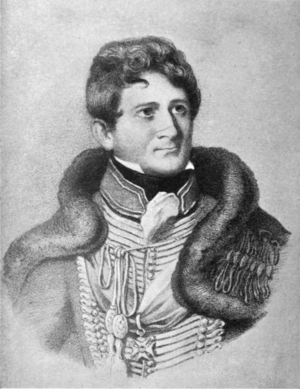Augustus Simon Frazer facts for kids
Quick facts for kids
Sir Augustus Frazer
|
|
|---|---|
 |
|
| Born | 5 September 1776 Dunkirk, France
|
| Died | 11 June 1835 (aged 58) Woolwich, England
|
| Education | High School, Edinburgh |
| Occupation | Military officer |
Sir Augustus Simon Frazer (KCB FRS) was born on September 5, 1776, and passed away on June 11, 1835. He was a very important military officer. He led the artillery during the British invasions of the Río de la Plata in 1807. Later, he commanded the Royal Horse Artillery for Wellington's army in the Peninsular War. He also played a key role in the famous Waterloo Campaign.
Contents
Early Life and Family
Augustus Frazer was born in Dunkirk, France. His father, Andrew Frazer, was an officer in the Royal Engineers. His mother was Charlotte. Augustus went to the High School of Edinburgh for his early education.
In 1809, Augustus Frazer married Emma Lynn. They had two sons. Their elder son, Augustus Henry, became an officer in the Royal Artillery. Their younger son, Andrew James, joined the Rifle Corps.
Military Career
Frazer started his military journey at the Royal Military Academy in Woolwich in 1790. He became a second lieutenant in the Royal Artillery in 1793. He quickly saw action in Flanders, serving with the Duke of York's army. He was promoted to First Lieutenant in 1794. He fought in battles like Tournay and Boxtel.
After returning to England, he joined the Royal Horse Artillery. In 1799, he took part in an expedition to Holland.
South American Expedition
In 1807, Frazer, now a captain, went to South America. He was part of an expedition to Buenos Aires. Even though the campaign didn't go well, Frazer showed great skill. He was very good at moving and placing artillery guns.
Fighting in the Peninsular War
In 1811, Frazer joined Wellington's army in the Peninsula. He fought in major battles like Salamanca and Battle of Vitoria. His accurate artillery fire at the Siege of San Sebastian was especially noted. He was even wounded during the investment of Bayonne.
After the fighting ended, he returned to England as a Lieutenant-Colonel. He received the Army Gold Medal for his bravery. He was also honored as a Knight Commander of the Order of the Bath.
Waterloo Campaign
In 1815, Sir Augustus Frazer was back in command of the Horse Artillery. He was part of Wellington's main team. He was at the Battle of Quatre Bras on June 16. His artillery helped cover the army's retreat, slowing down the French cavalry.
At the main battle of Waterloo, Frazer made a smart decision. He swapped some lighter 6-pounder guns for heavier 9-pounders. These bigger guns caused more damage to the French army, especially with their special "case shot" ammunition. His artillery also successfully pushed the French out of the woods around Hougemont.
Later Life
After his military service, Sir Augustus Frazer returned to England. In 1816, he was chosen to be a Fellow of the Royal Society, a group for important scientists. He became the Director of the Royal Laboratory at Woolwich. He passed away there on June 11, 1835.

